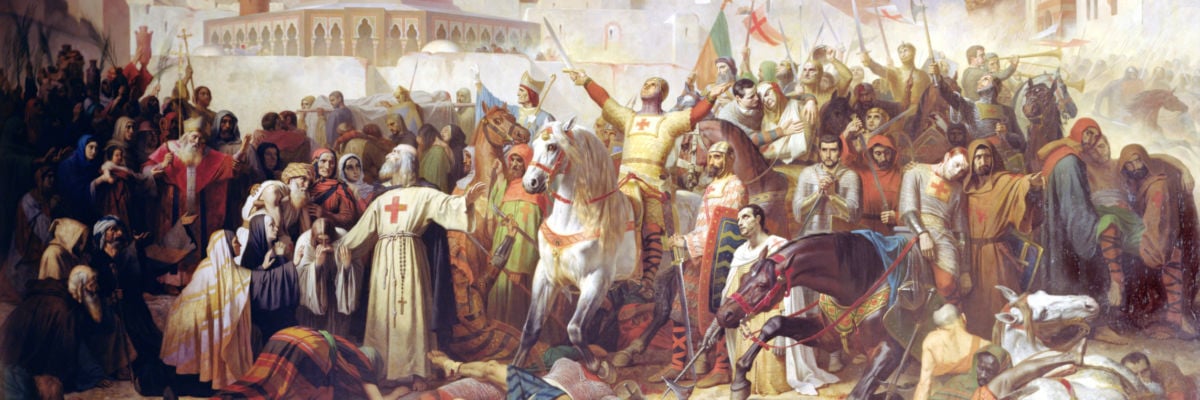
This post is the fourth in a series about the most prevalent modern myths about the Crusades and how to refute them.
This month we remember the 916th anniversary of the liberation of the Holy City of Jerusalem by the First Crusaders (July 15, 1099). News of the success of the First Crusade was enthusiastically welcomed by the inhabitants of Christendom. Unfortunately, Bl. Pope Urban II, who inaugurated the Crusading movement and centered its focus on Jerusalem, died before the news reached Rome.
The event was well remembered in Christendom for generations, and it is also recalled in the modern world, but in a less triumphant way. Modernity remembers the liberation of Jerusalem as the massacre of Jerusalem and the flashpoint that contributes to anti-Western feeling in the Islamic world. The actions of the First Crusaders after gaining entry into the city are cited as one reason why the Crusades should be considered shameful by Christians—a time in our history we would do well to either forget or to cower in shame at the mention.
This mentality, embraced at times even by Catholics, is rooted in the anti-Catholic rhetoric of Enlightenment authors, who used the Crusades to attack the Church and its influence in the public square. The rhetoric is reinforced today in the media that shapes popular perception of the Crusades. It is imperative for Catholics to know the real story of our history in order to defend the Church when it is attacked. So, what is the real story of the massacre of Jerusalem?
The lead units of the First Crusade army reached the inland road to Jerusalem in early June 1099. It had been an exhausting and miraculous journey. Famine, desertion, disease, and the battlefield had drained the army of 80 percent of its manpower. The veterans of this campaign had liberated the ancient Christian city of Nicaea (site of two ecumenical councils in 325 and 787), suffered through the Anatolian Death March, and fought in the great siege and battle of Antioch. They were exhausted and short of supplies but in high spirits as the goal of their armed pilgrimage was finally within reach.
They arrived at the walls of the Holy City on June 7 and prepared for a siege they knew would not be easy. Despite the lack of proper siege equipment, the army launched a general attack on June 13. Although the Crusaders breached the outer defensive wall in one section, they were unable to surmount the inner rampart and after heavy losses were forced to retreat. After a priest claimed a vision of the papal legate Bishop Adhemar (who had died after the siege of Antioch), the Crusaders in early July fasted for three days, marched as barefoot and unarmed penitents around the city, sang prayers, and carried relics. Buoyed by these spiritual practices, the Crusaders attacked Jerusalem in the final assault on Friday, July 15, which was the Feast of the Dispersal of the Apostles, and at three o’clock in the afternoon, the hour of Crucifixion, they entered the Holy City. Jerusalem was once again in Christian hands.
As was common in medieval warfare, in Christendom as well as in the Islamic world, a city that refused surrender found itself at the mercy of the attacking army once the army forced its way in, which is the reason why many city leaders came to terms with an attacker rather than risk a siege. Most attacking armies preferred the city’s surrender, since it spared the army casualities and prevented destruction of the city.
Once inside Jerusalem, the Crusaders went on a rampage and killed many Muslim troops as well as non-combatants. While there is no doubt many were killed, we must not exaggerate what happened. Many inhabitants of the city (including Jews) were not killed but captured and ransomed; others were expelled from the city. The killing is well known, because both Islamic and Christian chroniclers recorded it, although there are discrepancies among the various accounts. For example, some claim the massacre went on for several days, others that it occurred on the first day only. The Christian sources do not agree on how many were killed, and numbers range from several hundred to 10,000. Some Islamic sources provide widely inflated numbers, claiming upwards of 75,000 killed (the city’s entire population was between 20,000 and 30,000). It is probable that anywhere from several hundred to 3,000 were slain by the Crusaders.
One interesting thing is the similar language used in the Christian sources to describe the bloodshed, which was either ankle deep, calf deep, or up to the knees of horses. These descriptions have contributed to the modern interpretation of the event, since modern critics cite them as clear evidence of the horrific massacre. However, the language was not meant to be taken literally and was not intended to factually record the number of those killed (as most modern readers understand it) but was intended to mimic passages of Scripture which medieval people would instantly recall (see Revelation 14:20). In using well-known scriptural imagery, First Crusade commentators made the point that victory over Muslim forces throughout the Crusade and specifically at Jerusalem was ordained by God as a judgment against unbelievers.
Although the killing of civilians in Jerusalem cannot be justified, it can be explained as the actions of an army that had suffered greatly over the previous three years whose members were delirious with finally achieving their objective. Often ignored by modern critics of the Crusades is the precarious military situation faced by the Crusaders at the time. Although they had secured the city, they knew an Egyptian relief army was on the move, and perhaps the fear of leaving a sizable enemy presence in the city contributed to the killings.
War is a brutish affair, and massacres were by no means the sole province of Christian warriors on Crusade. The Muslim warlord Zengi massacred 6,000 Christian men, women, and children on Christmas Eve 1144 when he conquered the city of Edessa. Likewise, Baybars, the thirteenth-century Mamluk general-turned-sultan of Egypt, pursued a policy of aggressive jihad in his campaigns against Christian settlements in the Latin East. After conquering Antioch, he ordered the city gates closed and locked the entire Christian population trapped inside. All were massacred in a bloodbath so repulsive that it shocked even Muslim chroniclers. Those who point to the massacre of Jerusalem as proof that the Crusades were shameful should at least acknowledge that Christians in the Latin East suffered even more gruesome episodes at the hands of Muslims.
Understanding the context of historical events is crucial in evaluating the past actions of human beings. Misrepresenting those actions or applying them inappropriately to an entire historical movement is not proper history and contributes to a false narrative rather than the real story.



